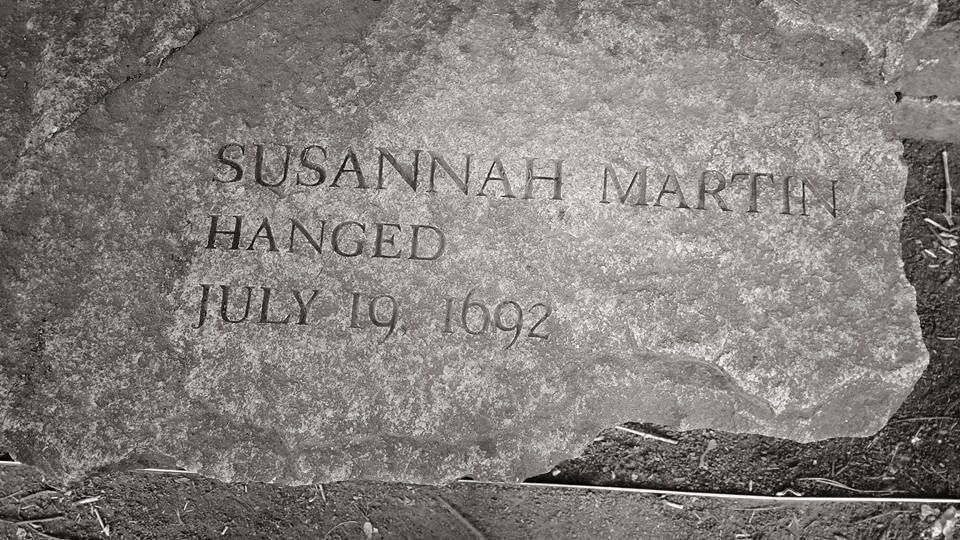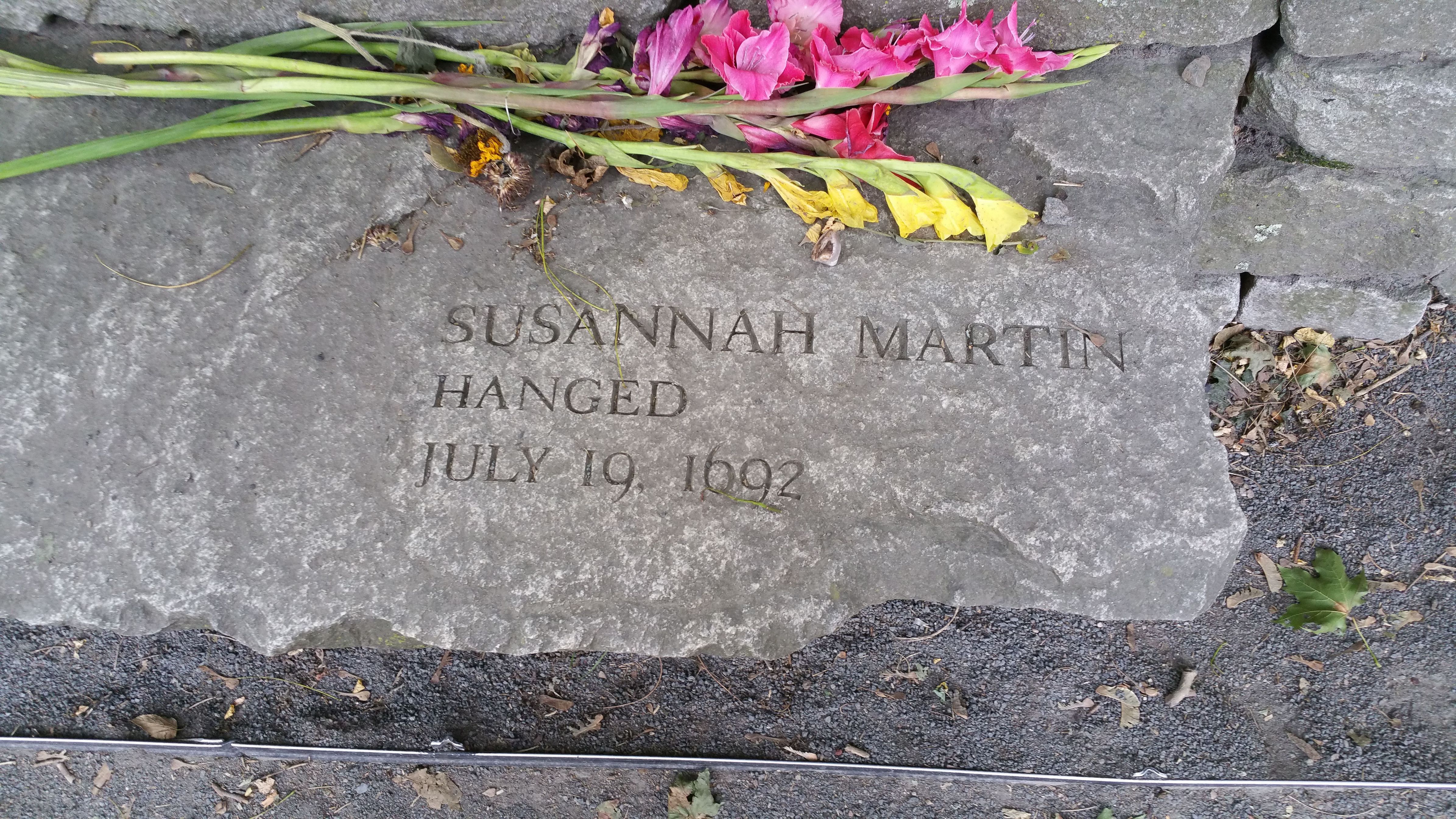---Susannah and George were the parents of eight children. Through her daughter, Jane, Susannah is the 5th great grandmother of U. S. President Chester A. Arthur. In 1669, William Sargent accused Susannah of witchcraft. George Martin sued Sargent for slander against Susannah and a higher court dismissed the witchcraft charges. George Martin died in 1686 and Susannah remained in Amesbury. In 1692, at the age of 71, she was accused of being a witch by several residents of Salem Village (now the Town of Danvers), which is located about 25 miles south of Amesbury.
---Susannah was arrested and tried for witchcraft. None of the accused were represented by council and during her trial, she defended herself defiantly. She was found guilty and hanged on July 19, 1692, along with four other women. All were placed in a shallow unmarked grave. Over 400 people were accused during the Salem witchcraft hysteria. Of those convicted, twenty were executed and four died in prison. In May, 1693, all of the remaining accused that had been arrested were released, but only after their families had paid jail and court costs.
--- In 1709, a petition was submitted requesting reversal of the convictions of 22 indiviuals. In October, 1711, this petition was approved by the General Court and in December, the Governor authorized monetary compensation to these individuals or their heirs. Susannah Martin's family did not sign this petition and she, along with others, were not included in this resolution. In 1957, an Act was passed pronouncing the innocence of "One Ann Pudeator and certain other persons." It was not until 2001 that an Act was passed amending the 1957 wording to include the names, "Ann Pudeator, Bridget Bishop, Susannah Martin, Alice Parker, Margaret Scott and Wilmot Redd.."
---A book published exclusively about Susannah North Martin is entitled ""A Laughing Witch: Hanging Susannah Martin"" by historian CL Gammon.
Summary: "In 1692, it did not pay to be a nonconformist in Salem Village, Massachusetts. This was especially true if the nonconformist just happened to be an elderly, improvised widow. Susannah Martin found this out the hard way. Susannah Martin stood trial, received a conviction, and suffered hanging for bewitching some of the good folk of Salem, Massachusetts and the surrounding area. More than two dozen persons related the crimes Martin committed.
—It seems that Susannah Martin's most heinous crime may have been that she had a sense of humor. When she heard the ridiculous accusations made against her, she laughed aloud. When the stern judge asked her what she was laughing at, she replied, "Well I may at such folly." While Martin's laughter may have doomed her, it is unlikely that she would have escaped even if she had been somber and had held her tongue.
—This brief volume deals with the accusations against, the trial, the conviction, and the execution of Susannah Martin for the infamous crime of witchcraft. While Martin was just one of the twenty persons killed by authorities in Salem (at least five others died in jail), her story is unique to the extent that she was one of the very few accused persons who saw and pointed out publicly the absurdity of the whole affair.
—Sadly, her story is not a comedy; it is a tragedy. Had the accusers, or more so, the judges been as able to release a boisterous laugh as was Susanna Martin's, we would view Salem Village in 1692 in a very different light."
---Susannah and George were the parents of eight children. Through her daughter, Jane, Susannah is the 5th great grandmother of U. S. President Chester A. Arthur. In 1669, William Sargent accused Susannah of witchcraft. George Martin sued Sargent for slander against Susannah and a higher court dismissed the witchcraft charges. George Martin died in 1686 and Susannah remained in Amesbury. In 1692, at the age of 71, she was accused of being a witch by several residents of Salem Village (now the Town of Danvers), which is located about 25 miles south of Amesbury.
---Susannah was arrested and tried for witchcraft. None of the accused were represented by council and during her trial, she defended herself defiantly. She was found guilty and hanged on July 19, 1692, along with four other women. All were placed in a shallow unmarked grave. Over 400 people were accused during the Salem witchcraft hysteria. Of those convicted, twenty were executed and four died in prison. In May, 1693, all of the remaining accused that had been arrested were released, but only after their families had paid jail and court costs.
--- In 1709, a petition was submitted requesting reversal of the convictions of 22 indiviuals. In October, 1711, this petition was approved by the General Court and in December, the Governor authorized monetary compensation to these individuals or their heirs. Susannah Martin's family did not sign this petition and she, along with others, were not included in this resolution. In 1957, an Act was passed pronouncing the innocence of "One Ann Pudeator and certain other persons." It was not until 2001 that an Act was passed amending the 1957 wording to include the names, "Ann Pudeator, Bridget Bishop, Susannah Martin, Alice Parker, Margaret Scott and Wilmot Redd.."
---A book published exclusively about Susannah North Martin is entitled ""A Laughing Witch: Hanging Susannah Martin"" by historian CL Gammon.
Summary: "In 1692, it did not pay to be a nonconformist in Salem Village, Massachusetts. This was especially true if the nonconformist just happened to be an elderly, improvised widow. Susannah Martin found this out the hard way. Susannah Martin stood trial, received a conviction, and suffered hanging for bewitching some of the good folk of Salem, Massachusetts and the surrounding area. More than two dozen persons related the crimes Martin committed.
—It seems that Susannah Martin's most heinous crime may have been that she had a sense of humor. When she heard the ridiculous accusations made against her, she laughed aloud. When the stern judge asked her what she was laughing at, she replied, "Well I may at such folly." While Martin's laughter may have doomed her, it is unlikely that she would have escaped even if she had been somber and had held her tongue.
—This brief volume deals with the accusations against, the trial, the conviction, and the execution of Susannah Martin for the infamous crime of witchcraft. While Martin was just one of the twenty persons killed by authorities in Salem (at least five others died in jail), her story is unique to the extent that she was one of the very few accused persons who saw and pointed out publicly the absurdity of the whole affair.
—Sadly, her story is not a comedy; it is a tragedy. Had the accusers, or more so, the judges been as able to release a boisterous laugh as was Susanna Martin's, we would view Salem Village in 1692 in a very different light."
Bio by: Eric
Family Members
Advertisement
See more Martin or North memorials in:
Records on Ancestry
Sponsored by Ancestry
Advertisement





